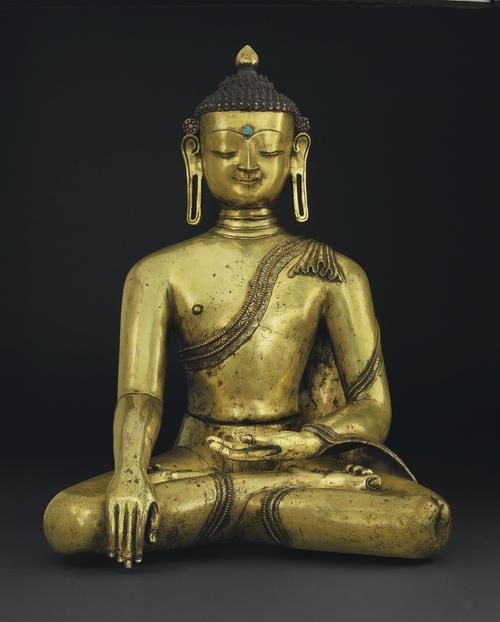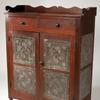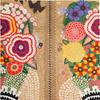SUPERB BRONZES, SCULPTURES, AND PAINTINGS LEAD CHRISTIE’S SALE OF INDIAN AND SOUTHEAST ASIAN ART IN MARCH
- NEW YORK, New York
- /
- March 07, 2012


New York – On March 21, Christie’s will present the sale of Indian and Southeast Asian Art, which covers a multitude of collecting categories, including Indian sculpture and paintings, as well as works of art from Gandhara, Tibet, Nepal, Thailand, and Indonesia. Among the sale highlights are a buff sandstone figure of Salabhanjika, a bronze figure of Manikkavacar, a gray schist figure of a bodhisattva, and a painting titled The Demon Sugriva Meets Ambika. Consisting of over 160 lots, the sale is expected to realize in excess of $5.6 million.
Highlighting the sale is a buff sandstone figure of Salabhanjika (estimate: $250,000 – 350,000). A favorite theme for bracket figures since antiquity, a goddess stands under a mango tree, grasping at its branches, which stems from the belief that spirits of fertility live in trees. Her features are idealized, with a voluptuous figure, full lips, and delicately arched eyebrow. Her clothing and jewelry emphasize her contours, moving past the restrained sensuality of earlier sculpture.
A rare bronze figure of Manikkavacar, the Shaiva saint who likely lived in the 9th century, with his right hand raised in the gesture of teaching and the left holding a book, will also be offered (estimate: $400,000 – 600,000). According to hymns, Manikkavacar was originally a minister to the King Varaguna of Madurai and was later banished from the Kingdom after using military funds to build a temple to the god Shiva. He then began his life as a wandering devotee, and eventually becoming revered for his piety and devotion.
A selection of Indian paintings will be included in the sale, led by The Demon Sugriva Meets Ambika of the Pahari region, circa 1775-1780 (estimate: $8,000 – 12,000). Executed as a continuous narrative of two scenes, the painting illustrates part of the story of Sumbha and Nisumbha, two demon brothers who begin the fifth chapter of the Devi Mahatmya. On the left, Ambika is seated on a rock-throne as the demon appeals to her; on the right, their demon emissary leaves after having been rejected by the goddess.

A large and important gilt bronze figure of Buddha will also be offered in the sale (estimate: $500,000 – 700,000). The bronze sculpture, which stands 23 inches tall, is elegantly modeled in the Newari style. Serenely seated in dhyanasana, the figure is constructed of two parts inconspicuously joined at the waist.
An extraordinary gray schist figure of a pensive bodhisattva will also be featured in the sale (estimate: $80,000 – 100,000). Originating in the Gandharan region during the Kushan period of the 2nd/3rd century, this figure incorporates features from regions throughout Asia, leading to the iconographic type of a seated Maitreya in Korea and Japan by the 7th century.
Also highlighting the sale is a large silver and copper-inlaid bronze figure of a lama (estimate: $280,000 – 350,000). This 15th century Tibetan sculpture depicts a lama seated in dhyanasana and is impressive in both its considerable size and its extensively detailed inlay. Elegantly rendered silver and copper is used to enhance the eyes, lips, and borders of his clothing.
A wonderful selection of thangkas are featured, including one from 15th century Tibet, which depicts Chaturmukha Mahakala (estimate: $60,000 – 80,000). The second of the principle protector deities in the Sakya tradition of Tibetan Buddhism, Chaturmukha Mahakala is commonly portrayed in five forms, all of which are represented in this thangka.
A rare conch shell with gilt copper mount is an exceptional work of art, with Tibeto-Chinese origins, circa 1736-1795 (estimate: $250,000 – 350,000). In Tibetan Buddhism, the conch is used to call together religious assemblies and is seen as the Voice of the Buddha and the transmission of Buddhist teachings. The elaborately decorated shell being offered is adorned with a gilt copper flange worked in relief with the Eight Auspicious Symbols, incised with the Qianlong yuzhi mark, and is fastened to a colorful silk streamer, beaded and embroidered with royal symbols.




10270x400_c.jpg)





100x100_c.jpg)







100x100_c.jpg)



